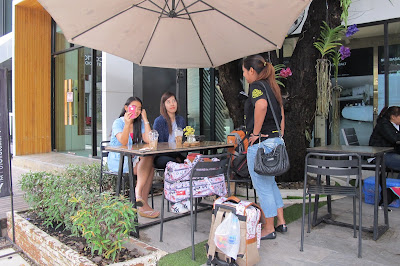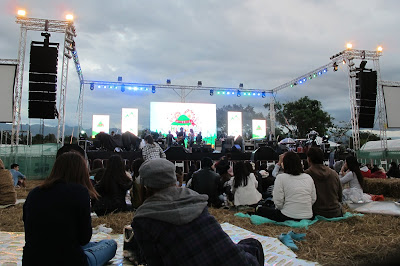ลมหนาว เริ่มมาแล้ว ขนาดภาคใต้ยังหนาวได้ขนาดนี้
...แล้วภาคเหนือ จะขนาดไหนเน้อ
เหมือนฟ้าจะเป็นใจ วันหนึ่งขณะราวน์เฟสรุ่นน้องก็ไปเจอเพจนี้
เชียงดาว ฟินฟันเฟส กับสโลแกนที่ว่ากอดลมห่มหมอก จัดเป็นปีแรกซะด้วย
ได้เวลาเปิดซิง ...มีรึพวกเราจะพลาด
สารภาพตรงๆ ตอนนั้นไม่รู้เลยจริงๆว่าเชียงดาวอยู่ส่วนไหนของเชียงใหม่ !!
พวกเรารวมตัวกันได้ 6 คน สาวล้วน โสดสโมสร เพราะบางคนเพิ่งอกหักมา
ช่วงนั้น Project Hello stranger อินไปอีก
สอยบัตรมาได้ในราคา early bird 500 ค่าเต็นท์กางคนละ 750 บาท นอนได้สองคน
ถ้าเอาเต็นท์มาเองเค้าคิดแต่ค่าพื้นที่ ซึ่งเอาเต้นมาเองคุ้มกว่าเห็นๆ แต่พวกเรายังไปต่อคงไม่สะดวกแบก
ลืมบอกค่ะ งานจัดวันที่ 10 มกราคม 2558 แฮ่แฮ่ เพิ่งว่างมารีวิวตอนนี้
หลังจากเราได้บัตรมาแล้วก็วางแผนเที่ยวกันต่อเลยดีค่ะ
เริ่มจากหาแผนที่ก่อนเลย เชียงดาวมันอยู่ตรงไหนน้า
และเราก็พบว่าเชียงดาวคือเมืองระหว่างตัวเมืองเชียงใหม่และอ่างขาง
นั่นเป็นที่มาของการเที่ยวสามดอยของเราในครานี้
เอาละเริ่มต้นลงที่สนามบินเชียงใหม่ วันนั้นบ้ามาก เราจองไฟล์ท 5.50
โอ้โห ตอนจองคิดอะไรอยู่ ...ไม่ต้องถามนะคะว่าตื่นกี่โมง น้องเพลีย
ไปถึงเราก็นั่งรอเพื่อนร่วมทริปอีกสองสาว อีกร่วมชั่วโมง
คือหกคนนี่แยกกันไป เจอกันที่เชียงใหม่เลยทีเดียว
หลังจากที่ลงเครื่องราว 10 โมงกว่าๆ เราเห็นเลยว่าไปสนามบินแฉะมาก ใช่แล้ว ฝนตก !!ขุ่นพระ
ยิ่งมั่นใจเข้าไปอีกเมื่อเราไปหาอะไรกินที่แถวนิมมานกัน เพราะนัดเจอสาวคนที่สี่ที่นี่
ส่วนอีกสองสาวเราเจอกันอีกทีที่คอนเสิร์ต
น้ำเจิ่งตามข้างทาง ซักถามคนแถวนั้นได้ความว่าเมื่อคืนฝนเพิ่งตกหนักมาก
ไม่รอช้าพวกเรา รีบเปิดเฟส เช็คข่าวสถานที่จัดงาน
ที่มาจากเพจงาน https://www.facebook.com/Chiangdaofinfunfest
ในเพจคนก็ชิงขายบัตร หั่นราคากันสุดฤทธิ์ ทั้งจากอากาศที่ฝนพรำ และสถานที่จัดงาน
ตอนนั้นแอบอุทานเบา ตายห่า!! แพร็ดแพร็ดมาก (แปลว่าเฉอะแฉะมาก)
น้องที่ไปด้วยจึงหลังไมค์ไปถามเพื่อที่อยู่เชียงใหม่ได้ รูปสถานที่จัดคอนเสิร์ต
โอ้โห ..บอกเลยว่านี่ดำนาได้เลย
แอบเครียดเลยค่ะตอนนั้น เพราะว่าพยายามวิ่งเข้าร้านสะดวกซื้อ
จำได้ว่ามันมีเสื้อกันฝนสีสันสดใสตัวละ 29 บาท
เชื่อมั๊ยวิ่งหาสามสาขาตลอดถนนนิมมานต์ มีแต่ของหมดค่ะ เข่าแทบทรุด
นี่มันตกหนักจริงๆใช่มั๊ย ...คือตอนนั้นฝนด้านนอกก็ยังพรำๆน้อยๆนะคะ
ไม่รอช้า พวกเรารีบจับรถแดงไปตลาด จัดการหาของยังชีพเพิ่มเติม เสื้อกันฝน
นอยด์มากค่ะตอนนั้น ผ้ารองนั่งพลาสติก รองเท้าบูท รวมถึงม้านั่งซักผ้า ซื้อถุงเท้าเพิ่ม
บางคนก็จัดรองเท้าเตะเพิ่ม เพราะกลัวโคลนติรองเท้าผ้าใบ เคยมาแล้วซักไม่ออก ><
เอาวะเพื่อนๆบอกว่าสู้ เป็นไงเป็นกัน
พอจัดการเรื่องปากท้อง เพื่อนๆ ก็ขอดริปกาแฟเข้าร่างกันก่อน
เมื่อพิธีกรรม เสร็จเราก็นั่งรถแดงไปที่ช้างเผือกค่ะ เพื่อจะขึ้นรถบัส
บ่ายโมงกว่าๆ ออกจากสถานีขนส่งช้างเผือก..ขึ้นรถบัส เชียงใหม่ -ฝาง-ท่าตอน ลงที่ อำเภอเชียงดาว ประมาณ 50 บาท ---ใช้เวลาประมาณเกือบ 2 ชั่วโมง
ระหว่างทางที่นั่งรถบัสร่วมๆ สองชั่วโมงกว่า เราพบว่าท้องฟ้าแจ่มใสและอากาศเริ่มร้อน
อาจจะด้วยพวกเราดูแปลก จึงมีคนมาคุยกับพวกเราเรื่อยเรื่อย
แต่เป็นที่น่าแปลกใจว่าพอเราบอกว่าเราจะไปคอนเสิร์ตที่เชียงดาวกัน ทุกคนทำหน้าแปลกใจแล้วถามว่า "มีด้วยเหรอ??นี่พี่อยู่แถวนั้นนะไม่เห็นรู้เรื่องเลย" แอบนอยด์เข้าไปใหญ่ แต่ยังไงก็แอบดีใจ อากาศร้อนแดดจ้า แม้ท้องฟ้าจะสลัว ก็พอทำให้ใจชื้นได้บ้าง
ถึงที่หมายเราก็ลง ที่นั่นจะเป็นที่รอรถ เราคุยกะคุณลุงได้ความว่าเหมาไปที่งานก็คิดประมาณ 150 บาท (ราคาไม่แม่นนะคะ สมองไม่ค่อยดี จำพลาดบ้าง) ที่จุดรอรถนั้นเราเจออีกสองสาวที่จะไปคอนเสิร์ตเหมือนกัน น้องเค้ามาจากกรุงเทพ นี่ไง..คนอื่นที่จะไปก็มีนี่นา
นั่งรถเหลืองไปได้ราว 15 นาทีค่ะ หลังจากจ่ายเงินเราก็ขอเบอร์โทรคุณลุงไว้ดีกว่า
ก็เผื่อพรุ่งนี้เราจะออกไปยังไง..วางแผนๆๆ อิอิ
ลืมบอกเราถึงบริเวณที่จัดงานประมาณ บ่ายสามครึ่ง เมื่อมาถึงที่ทำงานStaffยังวิ่งวุ่นกันอยู่เลยค่ะ
พื้นดินที่เราเห็นคือโรยฟางทั่วๆไปแล้วแต่ดินก็ยังหมาดๆอยู่
Staff พาเรามาที่เต็นท์ เราเป็นกลุ่มแรกที่มาเลยค่ะ ดูเค้ายังงงลำดับเต็นท์อยู่เลย นับแล้วนับอีกหลายรอบทีเดียว แต่ไม่เป็นไรอากาศดีมาก พวกเรารอได้ จขกท เอากระเป๋าล้อลากไป
ก็ถูลู่ถูกังลากไปทั้งๆดินเปียกนั่นแหละค่ะ
เต็นท์ใกล้กับเวทีเลยค่ะ เดินนิดเดียว ดังนั้นบ่ายนั้นเราจึงได้ยิน sound check อย่างชัดเจน
เมื่อมาถึงเต็นท์บรรยากาศดีมากค่ะไม่ร้อนจนเกินไปเพราะมีต้นไผ่บังแดดให้
มองวิวลงไปจะได้วิวนี้ ภาพที่เห็นสวยกว่ามองผ่านกล้องจริงๆค่ะ
ตอนแรกเราวางแผนจะไประเบียงดาวมั่งจะไปแช่น้ำร้อนมั่ง แต่อ่านรีวิวแล้วดูเข้าออกลำบาก จึงเปลี่ยนใจนอนจำศีลรอมื้อเย็นเลย
อย่าลืมนะคะ อิชั้นตื่นตีสามครึ่งวันนี้ ...กลับมาที่ประเด็นเดิม คิดอะไรอยู่น้าตอนจอง
เราก็เดินสำรวจบริเวณเต็นท์ เริ่มถอดเครื่องทรงแล้วค่ะ เพราะมันเริ่มร้อน
พอสัก ห้าโมงเย็นเราเดินไปหาอะไรกินก่อนเพราะเริ่มหิวแล้วตอนนั้นเริ่มมีคนทยอยมาบ้าง
ราคาก็อาหารก็มาตรฐานทั่วไปค่ะ เสต๊กหมู 99 สเต๊กปลาแซลมอน 139
คือแอบหันมองไปอีกด้านก็ต้องแอบลุ้นขออย่าให้ฝนเทลงมา
ตอนนั้นลมเริ่มแรงเหมือนฝนจิตก ..
แต่พอเรากินเสร็จหันไปบริเวณหน้าเวทีอีกโห โหคนเต็มแร้วอ่า
...ไม่เอาเค้ามาคนแรก เค้าอยากดูชัด ว่าแล้วก้จัดแจงหาที่นั่งแม้ไม่ใช่เซ็นเตอร์
แต่ก็ค่อนมาทางหน้าล่ะค่ะ
พื้นจะเย็นๆนิดนึง แต่พอช่วงเย็นลมเริ่มหนาวมาแล้วค่ะ พัดมาทีนี่ขนลุกเกรียว
แต่โชคดีที่พวกเราเตรียมมาเต็มที่ค่ะ legging , heattach , เสื้อหนาว ผ้าพันคอ หมวก ถุงเท้า ถุงมือ พวกขี้หนาวกันทั้งนั้น
คืนนั้นอากาศหนาวที่ประมาณ 10 องศาค่ะ แต่สิ่งที่ทำร้ายเราที่สุดนี่คือ ลม มากกว่าค่ะ
พัดมาทีนี่ขยับขาไม่ออกเลย
คอนเสิร์ตเริ่มด้วยลุลา เริ่มช้าไปราวชั่วโมงนิดๆ อ้อลืมบอกก่อนเริ่มงานมีน้องมาแสดงการละเล่นน่ารักดี และมีจุดพลุด้วย สวยและเยอะใช้ได้เลยค่ะกับสเกลคอนเสิร์ตระดับนี้
ลุลาน่ารัก และเสียงดี มีพลังมาก ประทับใจ
ลุลาร้องไปเช็ดน้ำหมาก เอ้ยน้ำมูกไป
เพราะลมแรงมาก แถมเวลาสูงกว่าก็ไม่แปลกที่บนเวทีจะหนาว
ขนาดพิธีกรเป็นผู้ชายยังปากสั่นเลย
วงต่อมาคือ
Jet'seter เพิ่งรู้ว่าพี่พี่เค้าฮา และมีอยากมีเพลงเชียร์ น่ารักดี
เจท เชส เตอร์.. เจท เซส เจทเซส ...เจทเซสเตอร์
วงต่อมาคือ Musketeer
ตอนนั้นเริ่มวิ่งเวียนกับการนอนน้อย หลังจากร้องไปได้หนึ่งเพลง
เราก็หลับสนิทไปเลยตรงนั้น น้องบอกว่าเกือบโดนเสื้อข้างหลังเหยียบหัว
แต่เราก็ไม่ตื่น มาตื่นอีกทีตอนจบแล้ว
แต่ไม่เป็นไรกำลังคืนมาแล้ว ร่างต้องการพักสักแปปเท่านั้น
สู้...

คนต่อมากรี๊ด เคยเจอพี่เค้าตอนดูคอนเสิร์ต Love is
เฮียอบอุ่นใส่ใจแฟนเพลงมากปลื้ม ..คือตอนจองเต็นท์ ถามรุ่นน้องว่าเค็นท์ไหนนอนกะพี่ตู่
น้องมันมีบอกเอียมีเมียแร้นนะ ..จ่ะ จะช่วยมโนก็ไม่ได้
และแน่นอนว่าเพลงฮิตช่วงนี้ต้องเป็นเพลงที่คุณพฤกษ์ ร้องให้ครูเพลงจร้า
คือเพื่อชีวิตก็มาได้นะงานนี้
อีกวงที่ออกมาแล้วมันมากๆๆ
บแกเลยพี่เจ๋งเอาอยู่ "เพลงพวกพี่ไม่ได้มีไว้เต้น แต่มีไว้โดด ว๊ากก"
มันส์มาก มันหนาวจนกระโดดไม่ไหว แต่พี่ก็บิ้วพวกหนูจนได้
คือลมหนาวขนาดนี้พี่เจ๋งเหงื่อท่วมตัวได้ พลังพี่เค้าเหลือเฟือจีจี
ต่อมาอีพี่ดา นางดูเปรี้ยวฮิปมากก
วงต่อมาคือ paradox
เชื่อแล้วที่เค้าว่าวงนี้แจกแหลก พี่ต้าพูดน้อยมากกแลดูเรียบร้อย
วงต่อมาพี่โจ้ แต่เสียดายเวลากระชั้นพี่แกเลยร้องแค่สามสิบนาทีเอง ตอนนั้นน่าจะตีสองกว่าแล้ว
เป็นวงรองสุดท้าย แต่อยากบอกพี่โจ้ว่าแดนเซอร์สาวแย่งซีนพี่มากจีจี
วงสุดท้ายก่อนพระจะมาเดินบาตรก็คือ
Tattoo Colour ยอมรับเลยว่าสนุก และนางถึกมาก คนดูก็ถึกได้อีก
หนาวมาก ยังเต้นกันไหว ร้องกันจนเสียงแหบ
พี่เค้าเลยจัดให้อีก ชั่วโมงนิดๆ
แทบคลานกลับเต็นท์ ไม่จบเราไม่ยอมกลับ
กว่าจะจบคอนเสิร์ตปาเข้าไปตีสี่ค่า วงสุดท้ายคือ เกลียดละคร ก็ยังดูมันทุกตอน ได้เวลาสะบัดความง่วง
สโลแกนของคอนเสิร์ตคือ เลิกพร้อมพระบิณฑบาตร เอิ่มม...พวกเรามีกันหกสาว ล่าถอยไปแล้วสี่
โอเคได้เวลานอนก็รีบไปแปรงฟัน แล้วเข้านอนกัน ...อืมมม
ต้องบอกมั๊ยคะว่านอนหลับรึเปล่า...คือ เต้นท์ดังรูป เป็นพลาสติกบางๆ ตั้งก็บนดินเหนียวเปียกค่ะหนาวสะท้านเข้ามาถึงทรวง ยิ่งมีน้ำค้างอีก #ร้องให้หนักมาก #น้ำมูกไหลหนักมากเช่นกัน
หลับๆตื่นๆ ที่งานมีห้องน้ำนะคะ เป็นแบบรถเคลื่อนที่ ก่อนคอนเสิร์ตก็สะอาดดีค่ะ โชคดีที่เราไม่ปวดหนักเลย ตื่นเช้าก็เราโทรคุยกับคุณลุงรถเหลือง เมื่อคืนนายอำเภอแนะนำสถานที่ศักดิ์สิทธิ์ คือ สมเด็จพระองค์ดำ ตอนเราไปยังมีร่องรอยการแก้บน หัวหมูวางเรียงรายไม่น้อยกว่าเจ็ดหัวค่า
เราจึงตกลงราคา พาไปที่นี่ก่อนบ่อน้ำร้อนยางปูโต๊ะ เนื่องจากพวกเราต้องได้รับการอาบน้ำล่ะค่ะ
แพลนที่วางไว้คืออาบและแช่ออนเซนริมคลอง ให้ตัวเบา แล้วค่อยเดินทางไปอ่างขางกัน
โป่งน้ำร้อนนี้เราอ่านเจอจาก Aday ฉบับที่เกี่ยวคนญี่ปุ่นมาทำธุรกิจที่เชียงใหม่ เราจึงรู้จักสถานที่แห่งนี้
ที่โป่งน้ำร้อนยางปู่โต๊ะ ตรงนี้จะเป็นบ่อน้ำร้อนฟรี ซึ่งเป็นบ่อปูนขนาดสี่คนลงได้กลางแจ้ง ได้บรรยากาศอีกแบบค่ะ แต่พวกเราต้องการอาบน้ำด้วย ก็จะมีออนเซนของเอกชนอยู่ติดๆกันเลยค่ะ
แช่ตัวเสร็จก็เกือบเที่ยงแล้วล่ะค่ะ โทรติดต่อคุณลุงรถเหลืองมารับไปที่จุดเดิมวันที่เราลงรถวันมาคราวนี้เราจะนั่งรถคันเดิมค่ะ ต่อไปลงที่ท่ารถฝาง เพราะที่นั่นเรานัดไกด์ไว้แล้ว ชื่อพี่เป้า โปรแกรมที่เราเลือกไว้คะ น้ำพุร้อนฝาง สวนส้มธนาธร และขึ้นไปนอนบนดอยอ่างขาง เช้าเที่ยวบนดอยอีกครึ่งวัน แล้วส่งลงที่คิวรถตู้ฝาง รวมทั้งหมด 2,600 บาท พี่เป้าเป็นชาวเขาที่อาศัยอยู่บนดอยอ่างขางค่ะ อัธยาศัยดีมาก ที่สำคัญถ่ายรูปเก่งใช้ได้เลยค่ะ มุมกล้อง พวกเรายิ่งบ้าถ่ายรูปอยู่แล้ว ถูกใจ มีการแนะนำจัดท่าด้วย
ที่แรกที่เราไปคือน้ำพุร้อน คือน้ำพุร้อนมันมีความพิเศษตรงที่มันจะประทุขึ้นมาทุก 30 นาที ตอนเราไปถึงก็ยังไม่ถึงเวลา เพื่อนก็เดินชมรอบๆไปก่อน ที่นี่จะมีกลิ่นกำมะถันเบาๆ บางคนก็มีนั่ง picnic ไข่ต้มกันสนุกเชียว พวกเราก็ร้องว้าวๆ Amazing Thailand แอบโดนเด็กร้ายข้างเหน็บเอา ..Amazing ของพี่เค้า พวกเราเห็นประจำเลยเนอะแม่เนอะ ...ต้องท่องเลย รักเด็ก รักเด็ก ฮึ่มมม
พอถึงเวลาจริงๆ โห!! มัน อัสจอรอหันการันยอ จริงๆสำหรับพวกเรานะ
ชื่นชมพอแล้วเสียดายเวลาเรากระชั้น อยากโดดลงแช่น้ำร้อนด้วยมากกก
พี่เป้าก็พาไปต่อที่สวนส้มธนาธร พี่เป้าเล่าว่านี่เป็นสวนที่ใหญ่ที่สุดในหลายๆไร่ที่เค้ามี
ก่อนไปเราแอบโทรไปถามก่อนแล้วว่าช่วงที่ไปมีผลส้มรึเปล่า กลัวเสียเที่ยว
เปิดให้เข้าชมทุกวันตั้งแต่เวลา 8.00-17.00 น.
สอบถามรายละเอียดเพิ่มเติมได้ที่ โทร. +66 5334 6554-6
ที่สวนส้มเค้าจะมีรถพาชมทั่วสวน
มาตามหาพี่อาทิจกัน ที่นี่เค้าเคยถ่าย ธรณีนี่นี้ใครครอง
ใครเคยดูน่าจะคุ้นๆตา
ได้เวลาแล้วเราไม่อยากขึ้นดอยมืดค่ำ ต้องโบกมือลาสวนส้มแร้น
ออกจากสวนส้มราวสี่โมงกว่า แล้วขึ้นดอยอ่างขาง รู้สึกว่าจะให้เวลาขึ้นชั่วโมงนิดๆ ตอนนั้นคิดถูกมากที่ไปกับเจ้าของพื้นที่เพราะมีทางโค้งหักศอกหลายที่ที่คนนั่งอย่างเรายังเสียว ถ้าขับเองคงเกร็งเยี่ยวเหนียวน่าดู ...ตอนขาขั้นอากาศเริ่มหนาวขึ้นเรื่อยๆค่ะ ลมพัดทีนี่..บรึ๋ยยย
แต่วิวสวยมากดอกนางพญาเสือโคร่งตลอดทางเลยทีเดียว ฟินกับความหนาวและความงามของดอกไม้ จนน้องสาวขอนั่งกระบะหลัง ซึ่งทุกคนส่วยหัวช้านไม่เอาด้วย ในรถช้านยังหนาว
กว่าจะถึงบนยอดดอยก็พลบค่ำแล้วค่ะ พี่เป้าขับผ่านตลาดไปส่งเราที่ที่พัก ซึ่งอยู่หลังตลาดคนเดิน เราสามารถเดินออกมาได้สบายๆ ถึงตอนนี้พูดทีควันออกปากที พวกเราพรอพแน่นแล้ว ยังหนาวค่ะ ดูอุณหภูมิที่ติดไว้คือ 6-8 องศา คุณป้าเจ้าของโรงแรมที่เรานอนบอกว่าเมื่อสองสามวันก่อนฝนตก แบบน้ำแข็ง ก็หนาวมาก โชคดีที่ตอนเราไปฝนไม่ตกแล้ว
จริงด้วยความที่กลัวว่าบนดอยจะหาอะไรกินยาก เราเลยจัดอาหารตามสั่งมาแล้วจากสวนส้ม แต่พอมาถึงก็ต้องสำรวจตลาดสักหน่อย หาอะไรกินคลายหนาวกันดีกว่า
ลืมบอกชื่อที่พักของพวกเรา ที่อ่างขาง เนื่องจากตรงกับช่วงอากาศหนาวและเป็นเสาร์อาทิตย์ ที่พักเต็มเยอะเลยค่ะ
ตื่นเช้าขึ้นมาพี่เป้านัดไปดูจุดชมวิวดวงอาทิตย์ขึ้นที่ขอบด้ง แต่เสียดาย เมื่อคืนมีฝนตกเล็กน้อยจึงมีหมอกมาก บดบังทัศนวิศัย
พวกเราเลยเดินคอตกมากินโจ๊กบริเวณนั้นแทน ที่ร้านโจ๊กที่เราชอบใจที่สุดคือกองไฟค่ะ ได้บรรยากาศมากกินโจ๊ผิงไฟไป คือหนาวจริง ตอนเช้าอุณหภูมิประมาณ 4 องศาค่ะ
สถานีเกษตรหลวงอ่างขาง ( ดอยอ่างขาง )
ที่นี่เรานอนที่แม่กลางหลวง
ตอนเช้า ประมาณ 5 โมง เพราะเราจะไปชมดวงอาทิตย์ขึ้นก่อนไปเดินเส้นทางธรรมชาติที่กิ่วแม่ปาน
วันนี้ขณะที่รอไข่แดงใบเขื่องอยู่นั้น เรายืนนิ่งไม่ได้นะคะ เพราะมันหนาวมาก มีเสียงประกาศว่าขณะนี้อุณหภูมิยอดดอย 0 องศา
เส้นทางนี้จะผ่านสภาพธรรมชาติที่แตกต่างกัน 2 ลักษณะ คือ ป่าดิบเขากับทุ่งหญ้าบนสันเขา ทางช่วงแรกผ่านเข้าไปในป่าดิบเขาซึ่งมีบรรยากาศร่มครึ้ม มีแสงแดดส่องลงมาเพียงรำไรตามพื้นป่าเต็มไปด้วยเฟินหลากหลายชนิด มีมอสสีเขียวขึ้นคลุมตามโคนต้นไม้และบริเวณริมห้วยที่ชุมชื้น ทางจะเดินขึ้นเขาจนทะลุออกยังทุ่งหญ้าโล่งกว้างของสันกิ่วแม่ปานซึ่งมีแสง แดดจ้าและสายลมแรง ทำให้บรรยากาศเปลี่ยนไปจากสภาพที่ผ่านมาทันที ทุ่งหญ้าบริเวณนี้เคยเป็นป่าดิบเขามาก่อน แต่ได้ถูกบุกรุกทำลายไปจนมีสภาพดังเช่นปัจจุบัน
ระยะทางทั้งหมดประมาณ 3 กิโลเมตร ใช้เวลาในการเดิน 2-3 ชั่วโมง เส้นทางนี้อยู่ที่ระดับความสูงประมาณ 2,000 เมตรจากระดับน้ำทะเล โดยจะมีเจ้าหน้าที่นำทาง 1 คน คิดค่าบริการต่อกรุ๊ปเพียง 200 บาทค่ะ
ทางอุทยานแห่งชาติดอยอินทนนท์มีศูนย์บริการนักท่องเที่ยวตั้งอยู่บริเวณกิโลเมตรที่ 9 ของเส้นทางหมายเลข 1009 มีเจ้าหน้าที่คอยให้คำแนะนำ และมีนิทรรศการเกี่ยวกับธรรมชาติ สัตว์ป่า และอื่น ๆ
เสร็จแล้วเรากลับลงมาที่พระมหาธาตุนภเมทนีดล และพระมหาธาตุนภพลภูมิสิริ
น้ำตกวชิรธาร
เป็นน้ำตกขนาดใหญ่ เดิมชื่อ “ตาดฆ้องโยง” น้ำจะดิ่งจากผาด้านบนตกลงสู่แอ่งน้ำเบื้องล่าง ในช่วงที่มีน้ำมากละอองน้ำจะสาดกระเซ็นไปทั่วบริเวณรู้สึกได้ถึงความเย็นและชุ่มชื้น และสะพานไม้ที่ทอดยาวเข้าไปหาหน้าผานั้นจะเปียกลื่นอยู่ตลอดเวลา ก่อนกลับไปแวะช้อบของกินของฝากที่กาดวโรรส กันก่อน
ด้านในตลาด เปิดกันตั้งแต่ 4.00-19.00 น. ส่วนบริเวณรอบตลาด ด้านนอกตึก จะเปิดตั้งแต่ 7.00 -24.00 น.



















































